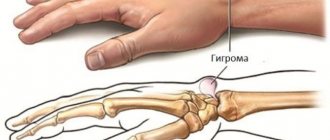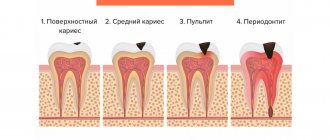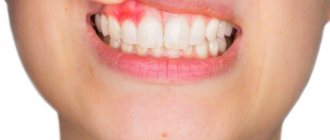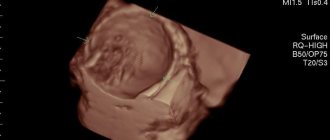From this article you will learn:
- what is a dental cyst - symptoms, photos,
- why does it form?
- cyst on the root of a tooth - treatment.
The article was written by a dentist with more than 19 years of experience.
A dental cyst is a round-shaped inflammatory formation, which is a cavity in the bone tissue, which is lined from the inside with a fibrous capsule and filled with purulent contents (Fig. 1). In dentistry, the terms “root cyst of the tooth” or “radicular cyst” (from the word radix - root) are most often used to refer to this pathology. This is due to the fact that the most common place for its formation is the area of the apex of the tooth root.
The formation of a cyst on the root of a tooth is associated with an infection in the root canals. Most often it appears - 1) either in the absence of timely treatment of pulpitis or periodontitis of the tooth, 2) or is a consequence of poor-quality root canal filling. The formation of a cyst occurs gradually and over a long period of time. First, at the apex of the root, under the influence of infection in the root canals, a small apical granuloma is formed, which subsequently increases in size and transforms into a cyst filled with pus.
What does a dental cyst look like: photo
Pay attention to how a cyst on the root of a tooth looks on an x-ray - it looks like intense darkening at the apex of the tooth (for your convenience, we have limited this area with arrows). Such intense darkening at the apex of the tooth root indicates the presence in the bone tissue of a site of bone destruction in the form of a cavity. In Fig. 3 you can see what a cyst looks like at the apex of the root of an extracted tooth (like a sac filled with pus).
This article is written for patients and therefore will contain unnecessary medical details. But to complete the picture, it is worth adding that a dental cyst can be localized not only at the apex of the tooth root, but also on the lateral surface of the root, as well as between the roots of multi-rooted teeth - in the root bifurcation zone. But such localizations of root cysts are quite rare, and therefore we will examine in more detail the symptoms and treatment of a dental cyst localized at the apex of the root.
Type of cyst on the root of an extracted tooth (video 1) –
What is a dental cyst?
A dental cyst (from the Greek “kystis” - bubble) is an inflammatory formation in the form of a granule, which occurs as a result of the body’s protective reaction to infection or injury. Externally, the neoplasm is a bubble up to several centimeters in diameter, filled with fluid or pus. The fact is that when the body tries to fight inflammation on its own, the affected cells begin to die, and in order to isolate them from healthy tissues, a membrane forms around them. You can see this cavity in the early stages on an orthopantomogram.
Clinical researches
Repeated clinical studies have proven that the two-component mouth rinse ASEPTA ACTIVE more effectively combats the causes of inflammation and bleeding compared to single-component rinses - it reduces inflammation by 41% and reduces bleeding gums by 43%.
Sources:
- The role of anti-inflammatory rinse in the treatment of periodontal diseases (L.Yu. Orekhova, A.A. Leontyev, S.B. Ulitovsky) L.Yu. OREKHOVA, Doctor of Medical Sciences, Prof., Head of Department; A.A. LEONTIEV, dentist; S.B. ULITOVSKY, Doctor of Medical Sciences, Prof. Department of Therapeutic Dentistry of St. Petersburg State Medical University named after. acad. I. P. Pavlova
- Report on the determination/confirmation of the preventive properties of personal oral hygiene products “ASEPTA PLUS” Remineralization doctor-researcher A.A. Leontyev, head Department of Preventive Dentistry, Doctor of Medical Sciences, Professor S.B. Ulitovsky First St. Petersburg State Medical University named after. acad. I.P. Pavlova, Department of Preventive Dentistry
- Clinical studies of antisensitive toothpaste “Asepta Sensitive” (A.A. Leontyev, O.V. Kalinina, S.B. Ulitovsky) A.A. LEONTIEV, dentist O.V. KALININA, dentist S.B. ULITOVSKY, Doctor of Medical Sciences, Prof. Department of Therapeutic Dentistry, St. Petersburg State Medical University named after. acad. I.P. Pavlova
Why does a dental cyst appear?
The main causes of cysts in teeth are:
- Development of infection in the root canal of a tooth
- Injury
- Chronic diseases of the oral cavity and nasopharynx
- Inflammation of periodontal tissues (periodontitis, periodontitis)
- Reduced immunity
- Caries
- Poorly installed filling or crown
- Difficult eruption of wisdom teeth
Causes of the disease
Other diseases and bad habits can lead to the development of this disease, such as:
- viral and bacterial infections;
- nicotine abuse;
- weakened immune system;
- sinusitis and tonsillitis;
- ARVI;
- dental diseases.
Risk factors are:
- hypothermia;
- increased mental and physical stress;
- frequent stress.
The influence of factors often leads to accelerated tumor growth. Teeth that were previously filled or reconstructed are most susceptible to this disease.
Symptoms of a dental cyst
The difficulty in diagnosing a cyst lies in the absence of symptoms. In some cases, a person may pay attention to such signs of a dental cyst as darkening of the enamel, slight displacement of the tooth and discomfort when chewing solid food, but most do not attach any importance to this. By the time pain from a dental cyst begins to appear, the granule can already grow up to 1 cm in diameter. From this moment on, the patient begins to feel other quite noticeable signs. Here are the symptoms of a dental cyst that may appear at this stage:
- aching pain in the area of inflammation;
- swelling, which can spread to the face;
- enlarged and painful lymph nodes;
- elevated temperature;
- headaches - with the development of a cyst in the maxillary sinus;
- general malaise.
Under no circumstances should these symptoms be ignored, otherwise serious consequences will arise, and removing a tooth with a cyst is not the worst of them. At the first signs of the development of the disease, you should consult a specialist.
What is the difference between a cyst and a granuloma?
A dental cyst is often confused with a granuloma, another dangerous disease in which a round-shaped formation forms in the root area. It is important to distinguish between them, since the diagnosis directly affects the treatment plan and its prognosis. For granuloma, in most cases therapeutic treatment is sufficient. But a cyst requires more radical measures.
Here are the main parameters by which a dental cyst and a dental granuloma differ:
| Difference options | Cyst | Granuloma |
| Size | 0.9 - 3 cm | 0.5 - 0.8 cm |
| Structure | Cavity with fluid or pus | Solid formation covered with connective tissue |
| Clinical picture | The tooth becomes mobile | No mobility observed |
| X-ray result | The image shows a round capsule with clear boundaries | There are no strict outlines of education |
| Condition of periodontal tissues | The mucous membrane is usually not inflamed. In this case, bone loss occurs. | There is severe swelling and redness of the mucous membrane. But bone tissue does not decrease so much that it can be detected clinically. |
X-ray diagnostics –
As we said above, the final diagnosis can only be made using an x-ray, on which a cavity formation in bone tissue will always look like a rounded darkening.
In the x-ray images below we have presented you with 3 options for localizing root cysts. The most common location is root cysts at the apex of the tooth root, but cysts on the lateral surface of the root or located between the roots of multi-rooted teeth are much less common. Radiographs of root cysts of different locations –
Types of dental cysts
There are several types of molar cysts, which are classified according to location and depending on the reasons for their formation.
Depending on the location, the following types of cysts are divided:
- A cyst on the root of a tooth: it can be interradicular, peri-radicular and basal. With a tooth root cyst, symptoms do not appear for a long time, and only at a late stage does a purulent capsule form and pain appear.
- Cyst on the gum: with this type of dental cyst, the fistula can form in any area of the gums; filling with pus occurs a little later. A cyst near a tooth may be accompanied by a tingling sensation. As with other cases of fistula formation, the consequences of a cyst in the gum of a tooth are quite serious.
- A dental cyst in the maxillary sinus: can only be diagnosed with the help of special equipment, since otherwise it is impossible to notice even a large dental cyst in the maxillary sinus. With an advanced dental cyst, sinusitis can become a sad and very unpleasant consequence.
- Cyst under the crown of a tooth: most often this is a cyst after dental treatment that was unsuccessful. In this case, a bubble is formed when the crown is installed incorrectly - as a result of the accumulation of food and the proliferation of bacteria. It is quite difficult to detect this type of cyst at an early stage. To treat a tooth cyst with a crown, the latter will need to be removed.
- Wisdom tooth cyst: appears as a result of difficult eruption or chronic inflammation of the “eights”. The only treatment option is to remove the affected tooth.
The cyst of the front tooth should be specially noted. In general, the disease does not differ greatly from other types, however, due to the fact that the teeth in the anterior section are much narrower, this affects the volume of the surrounding soft tissues. Therefore, an upper tooth cyst (or a lower tooth cyst) in the front part of the jaw has much less room for localization, and it begins to come out only in the gum area. For comparison, a cyst on the back teeth can form a fistulous tract even through the cheek or neck.
According to the reasons for their appearance, the following types of cysts are distinguished:
- Radicular
or odontogenic dental cyst: the most common type. It is formed in the upper third of the dental root from a granuloma - as a result of pulp necrosis and periapical (at the root apex) inflammation. The diameter of a radicular dental cyst varies from 2 mm to 3 cm. If there is no secondary inflammation, the disease is asymptomatic, there is no displacement of teeth or effects on bone tissue. - Residual
: a cyst after tooth extraction, formed in a situation where the root apex was not completely removed or a granuloma formed in the area of the missing tooth. A cyst after tooth extraction has the same properties as a radicular one. - Keratocyst
, also called primary and primordial: formed due to a developmental disorder. No tooth is immune from this, but most often it is a cyst due to inflammation in the area of the premolars and third molar of the lower jaw. With its development, the likelihood of relapse is high. - Teething cyst
, or retention cyst: is formed during the period of replacement of primary dental units with permanent ones. A tooth retention cyst looks like a bluish swelling that contains blood inside. In most cases, the fistula is formed due to slow eruption and can open at any time. - Follicular
: formed in a situation where a tooth for some reason cannot erupt and grows inside the soft tissue. As a result, a cyst forms on the gum around the tooth. Such a cyst grows quickly, can move to other teeth and is fraught with extensive damage to them. With the development of a follicular dental cyst, complications can be expressed in the tilting of adjacent teeth, displacement of unerupted teeth, and root resorption. - Lateral periodontal
: the exact causes of occurrence are not fully determined. As a rule, these are small cysts associated with the lateral surface of the tooth root. - Calcifying odontogenic
: formed in the area of the supporting surface mainly of the lower jaw. The reasons for its appearance are also not fully understood.
What to do with a dental cyst?
Since it is difficult to identify a cyst under a tooth, since it forms slowly and without pronounced symptoms, patients often turn to the doctor in the later stages of the disease - when pain, malaise and other signs of inflammation are felt.
Previously, in such a situation, the only way out was to remove the affected tooth. Today, there are different methods for treating cysts without losing a tooth. Depending on the degree of the disease, you can get rid of it therapeutically or surgically.
Therapeutic treatment includes cleaning out the cyst from the canals, treating them and filling them. Surgical treatment involves removing the damaged part of the tooth root while preserving the tooth itself. In this case, the cyst is eliminated and the missing tissue is replaced with a special material.
Today, indications for tooth extraction due to a cyst are special cases that threaten complications, as well as a wisdom tooth cyst.
Is it possible not to treat a dental cyst? Only if it appeared in a child before the change of baby teeth, over time such a tooth cyst will burst on its own, due to the friction of the gums against each other.
Surgery
Most often, a cystectomy procedure is performed to surgically remove a tumor. It involves removing the cyst and damaged root tip. The advantage of this method is its high efficiency. Its disadvantages include the fact that cystectomy is a rather complex operation, and not every surgeon decides to perform it.
A more complex method is hemisection. This operation is performed when one of the roots is completely destroyed. During surgery, the doctor removes the disease-causing capsule, damaged root and part of the tooth crown. The defect resulting from surgical resection is eliminated using composite materials or a crown.
Much depends on at what stage the capsule was discovered. Treatment can be accompanied by tooth extraction only if it is entirely located in the capsule of the cyst or its tissues are almost completely destroyed.
Why is a dental cyst dangerous?
The irony is that, forming as a result of the body’s defensive reaction, a cyst under a tooth can ultimately lead to serious complications. The main ones:
- Periodontitis: an advanced case of dental cyst, in which inflammation from the tooth tissue spreads to the bone.
- Flux: purulent inflammation in the subgingival and subnasal jaw area. This complication of a dental cyst is accompanied by swelling of the soft tissues, including the cheeks, and severe pain.
- Tooth loss: occurs if the cyst is not treated. In this case, the lesion spreads to adjacent teeth (although the cyst itself is not an indication for removal).
In addition to the above, exacerbation of the disease can lead to even more serious consequences: purulent abscess, inflammation of the lymph nodes, osteomyelitis, sepsis and even a jaw fracture. Therefore, if you are diagnosed with a cyst, treatment should follow immediately.
Important!
The earlier a dental cyst is detected, the higher the chances of its successful treatment. So, instead of struggling with the consequences of a dental cyst, visit your dentist regularly and undergo preventive examinations to maintain oral health.
Consequences of the appearance
The consequences can be very diverse, ranging from destruction of tooth roots to the formation of cancerous tumors. Periodically, the gingival cyst becomes active, becomes inflamed, gumboil forms on the cheek, the patient’s general condition worsens sharply, and severe toothaches and headaches appear. Moreover, even banal hypothermia, a cold, or severe stress can become an impetus for exacerbation of the disease.
If the cyst is not detected in a timely manner and it has grown greatly, destroying the jaw, even a spontaneous fracture of the jaw may occur. Fortunately, this happens extremely rarely, and you can avoid such consequences by systematically visiting a dentist and checking the condition of your teeth.
If pyogenic bacteria penetrate into the cavity of the cyst, an acute inflammatory process may occur, which threatens the occurrence of osteomyelitis and forms a fistula on the gum or cheek, through which purulent exudate flows out.
Patients are also interested in whether a malignant dental cyst can occur. In fact, it is a benign formation and in itself does not pose a direct threat to the patient’s life. But over time, if left untreated, it can cause cancer. Therefore, the formation of a granuloma or cyst should not be taken lightly.








